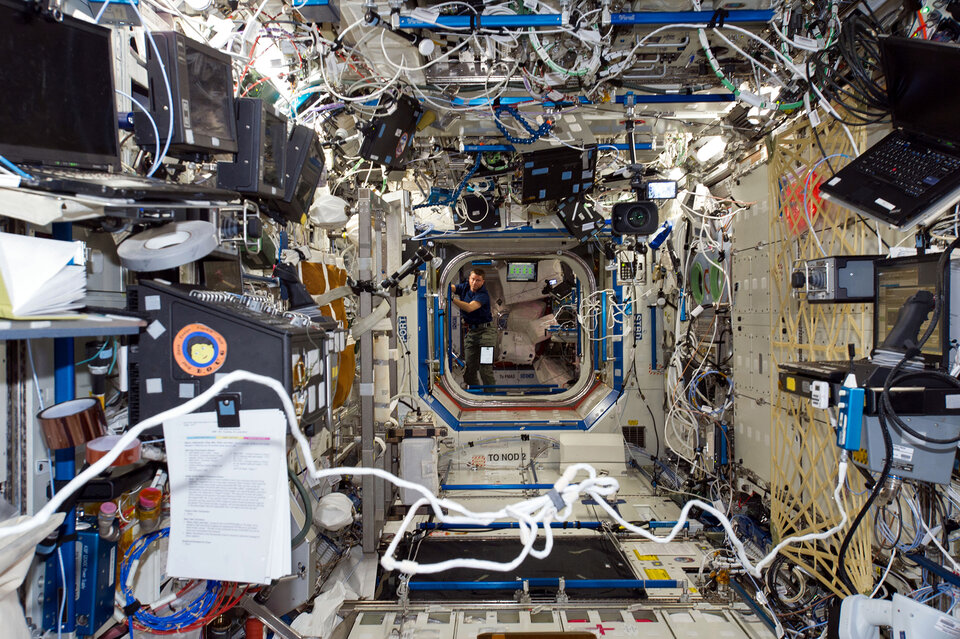Advanced Closed Loop System
ESA’s Advanced Closed Loop System (ACLS) recycles carbon dioxide on the Space Station into oxygen. For years oxygen on the Space Station was extracted from water that is brought from Earth, a costly and limiting drawback. The new system recycles half of the carbon dioxide thereby saving about 400 l of water that needs to be launched to the International Space Station each year.
The facility is a Space Station-standard 2-m tall rack. Although the system is made to demonstrate the new technology, it will be part of the Space Station’s life support system and produce oxygen for three astronauts, and operated for at least 1 year over 2 years to demonstrate its performance and reliability.

The system traps carbon dioxide from the air as it passes through small beads made from a unique amine developed by ESA for human spaceflight. Steam is then used to extract the carbon dioxide and process it in a Sabatier reactor to create methane and water. Electrolysis then splits the water back into oxygen while the methane is vented into space.
The system is a huge step for human spaceflight as space agencies prepare for exploring further from Earth. Sustainable life-support systems are needed for longer missions such as to the lunar Gateway that is the next structure to be built by the partners of the International Space Station. Foreseen as a staging post for missions to the Moon and even Mars the Gateway will be further away from Earth so harder and more expensive to ferry supplies.
The Advanced Closed Loop System hardware is part of ESA’s goal to create a closed life-support system, including water recovery and food production, eventually to keep astronauts in space indefinitely without costly supplies from Earth.
Process

ACLS can produce water from carbon dioxide exhaled by astronauts inside spacecraft. This water then is used to produce oxygen for the crew. It has three major functions:
- The Carbon dioxide Concentration Assembly (CCA) concentrates carbon dioxide from cabin air and keeps carbon dioxide within acceptable levels.
- The Oxygen Generation Assembly (OGA) is an electrolyser that separates water into oxygen and hydrogen.
- The recycling step takes place in the Carbon dioxide Reprocessing Assembly (CRA) or ‘Sabatier reactor’. Hydrogen, coming from the Oxygen Generation Assembly, and carbon dioxide react over a catalyst to form water and methane. The water is condensed and separated from the product gas stream and fed back to the electrolyser. Methane is vented into space together with excess carbon dioxide, which explains why only 50% of the recovered CO2 is actually recovered.
Facts

- Installed in US Destiny module.
- Can generate about 50% of the water needed for oxygen production on the Space Station
- Sent to space on Japan’s HTV-7 Vehicle
- Built by Airbus
- Built as International Standard Payload Rack, 1.57 m3 – about 2 m high, 1 m wide, and 85.9 cm deep.















 Germany
Germany
 Austria
Austria
 Belgium
Belgium
 Denmark
Denmark
 Spain
Spain
 Estonia
Estonia
 Finland
Finland
 France
France
 Greece
Greece
 Hungary
Hungary
 Ireland
Ireland
 Italy
Italy
 Luxembourg
Luxembourg
 Norway
Norway
 The Netherlands
The Netherlands
 Poland
Poland
 Portugal
Portugal
 Czechia
Czechia
 Romania
Romania
 United Kingdom
United Kingdom
 Slovenia
Slovenia
 Sweden
Sweden
 Switzerland
Switzerland




























